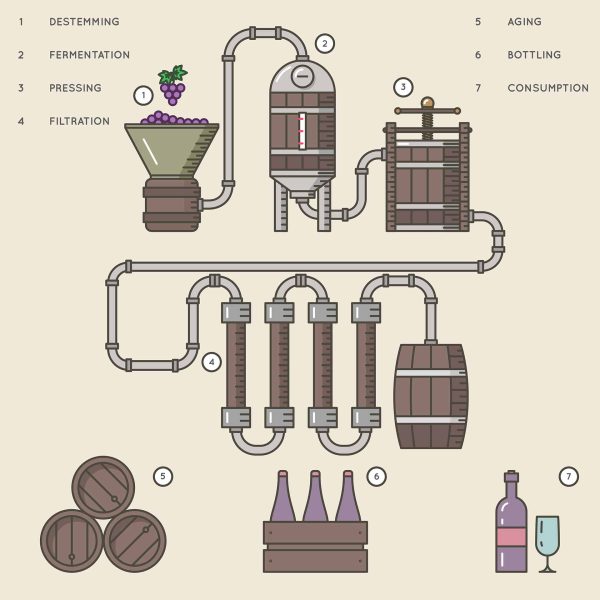- IELTS WRITING TASK 1 - PROCESS DIAGRAM
WINE MAKING PROCESS
You should spend about 20 minutes on this task.
Task: The diagram illustrates the various stages involved in the production of wine, from destemming to consumption. Summarize the information by selecting and reporting the main features, and make comparisons where relevant.
Write at least 150 words.

Designed by macrovector | Freepik
Sample Answer, C1 English Level, Advanced, Band Score 6.5-7.5
The journey of wine production is a meticulously orchestrated series of stages, each adding a unique flavor and dimension to the final product. It all begins with destemming, where ripe grapes are carefully separated from their stems to ensure only the best fruit is used. Following this, fermentation takes the spotlight, as natural or added yeast transforms grape sugars into alcohol, forming the foundation of the wine.
Subsequently, pressing comes into play, extracting the liquid or “must” from the fermented grapes. Filtration follows, removing any solids and clarifying the liquid. Aging takes center stage next, as the wine matures in various types of barrels, absorbing nuanced flavors and textures.
As the wine develops character through aging, it’s time for bottling. This step demands precision, preserving the wine’s essence until it’s uncorked for enjoyment. Ultimately, the process culminates in the pleasure of wine consumption, where every sip tells a story of skillful craftsmanship and nature’s influence. This intricate journey brings to life the artistry and science behind this cherished beverage.
Crafting wine involves a careful series of stages, each contributing to the final product’s unique qualities. It begins with destemming, where ripe grapes are separated from their stems for better quality. Fermentation follows, where yeast turns grape sugars into alcohol, forming the wine’s foundation.
Next, pressing extracts the liquid, or “must,” from the fermented grapes. Filtration comes after, removing solids and improving clarity. Aging then takes the spotlight as the wine matures in different barrels, gaining distinct flavors.
As the wine gains complexity through aging, bottling becomes pivotal. This step demands precision to preserve the wine’s essence for enjoyment. The process concludes with the pleasure of wine consumption, where each sip showcases craftsmanship and nature’s influence.
In short, wine crafting comprises a sequence of stages, from destemming to bottling, each shaping the wine’s character. This intricate process blends science and art, resulting in the diverse array of wines cherished worldwide.
Wine production is a symphony of stages, meticulously orchestrated to transform sun-soaked grapes into a masterpiece. Beginning with destemming, only the finest, ripe grapes are chosen, setting the stage for excellence. Fermentation follows, as yeast performs its alchemical magic, converting grape sugars into the elixir of life – alcohol. This foundation shapes the wine’s character.
Pressing extracts the liquid treasure, known as “must,” from the fermented grapes, a crucial step before filtration refines clarity. The stage of aging unfolds, as wine matures in barrels, absorbing nuances from each vessel. Bottling seals the journey, encapsulating the culmination of craftsmanship.
Ultimately, the symphony crescendos in consumption. With every sip, the culmination of human dedication and nature’s bounty is unveiled, a testament to the intricate dance of art and science. Wine’s story is one of transformation, from destemming to bottling, a tale that embraces the heritage of vineyards and the touch of human hands.

